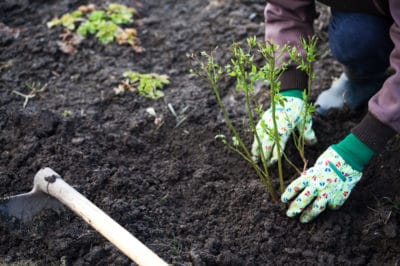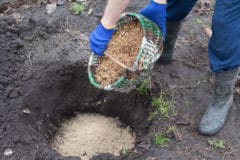Before Transplanting Blueberries
Before choosing your blueberry varieties and transplanting them to your garden, make sure your garden location and soil conditions are compatible with growing blueberries. Blueberries require the following conditions:
- Full sun for six to eight hours daily
- Acidic soil with a pH of 4.5 to 5.6
- Well-drained soil rich in nitrogen
- Organic matter such as, peat moss, dried leaves, pine bark or compost mixed into the soil
Choosing Blueberry Bushes
Most garden centers sell young blueberry bushes in the spring or fall. When you select your bushes, pick the ones that are at least two years old and appear healthy. Check for any diseased foliage or canes. Also, watch for pests inhabiting the soil or foliage. Take a look at the roots, making sure they have white tips, and they are not root bound.
Prepare the Planting Site
The best time to transplant your blueberry bushes is in the spring or fall when they’re still dormant. If your garden soil doesn’t meet the requirements for growing blueberries, you can plant them in raised beds or containers, using acidic potting soil.
When you transplant your berry bushes, the depth is important for providing air circulation and the correct amount of water. Blueberries grow shallow roots, so keep in mind the following depth requirements for planting blueberries:
- Too deep – The bushes can become water-logged and die from poor air circulation.
- Medium depth – This can cause slow root development and poor plant growth.
- Shallow depth – The root ball of your blueberry bush should be just below the soil. This gives your blueberries the best chance for healthy growth
Spacing Blueberry Bushes
Once you’ve determined the depth you need for your plants, space them from 3 to 4 feet apart. If you have more than one row, space the rows 5 to 6 feet apart. The hole for the blueberry transplant should be about a 12-inch diameter for a two-year-old plant.
Before placing your transplant in the hole, loosen up the soil around the root ball. Many times, the roots can’t break through a compacted root ball, so you need to help it out. Apply organic mulch around the blueberry bushes, and then cover that with dried leaves or pine bark.
After Transplanting Blueberries
Water your transplants thoroughly after you plant them. Also, prune the blueberry bushes, removing any dead or damaged canes. For healthy growth, only three or four upright branches should remain on the bush. If the young branches appear weak, you can stake them until they become stronger.












